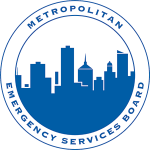9-1-1 Location Data
9-1-1 requests for service are routed to Public Safety Answering Points (PSAPs) based on location data provided to the 9-1-1 network by the caller’s telecommunications service provider. This location data may be in the form of a civic address where the service is installed, a location of a wireless cell sector from which the call was placed, or a coordinate location. In some instances, updated locations of mobile callers may be provided to the PSAP after the 9-1-1 call has been answered. Technologies used by service providers to locate a 9-1-1 caller and supply that location to the 9-1-1 system are evolving and improving as the industry moves toward next-generation 9-1-1 networks.
How are the MESB and its member counties currently involved with 9-1-1 location data?
Since the implementation of the metropolitan area 9-1-1 system, the MESB, its member counties, and the PSAPs have provided and maintained the data used by the 9-1-1 system to validate 9-1-1 caller locations provided to the 9-1-1 network. Civic addresses have been validated against a Master Street Address Guide (MSAG) detailing the official street addressing details in metropolitan region cities, townships, and unorganized territories. Wireless cell sector coverage areas from carriers has been reviewed by the MESB and the PSAPs to determine appropriate 9-1-1 routing. PSAPs report 9-1-1 data errors to telecommunications service providers and/or their database providers for investigation and correction.
How are the MESB and its member counties preparing 9-1-1 location data for the future?
In recent years, the MESB and its member counties have engaged in collaborative projects to facilitate the creation and maintenance of authoritative, locally-sourced, regional geospatial datasets that meet core business needs, including next-generation 9-1-1 call routing and location validation, emergency services dispatching, address geocoding, vehicular routing, and cartographic representation. Extensive work has been underway by local government at all levels to synchronize existing 9-1-1 data with the regional geospatial datasets that will be used for 9-1-1 in the future.
Where can I obtain more information on 9-1-1 data?
Visit the following webpages:
- Road Centerline:
- Address Points:
- MetroGIS Regional Geographic Information Systems Initiatives
- Statewide Status of 9-1-1/GIS Data Readiness for NG9-1-1
- Minnesota Geospatial Standards, Domains and Lookup Tables
- Provisioning Geospatial (GIS) Data from Local and County Sources for Translation and Usage into the Planned Statewide NextGen 9-1-1 System in Minnesota
What can I do if the location data on my 9-1-1 call is incorrect?
Callers who dial 9-1-1 from wireline or fixed location Voice-over-IP (VoIP) telephones in Minnesota and are told by the PSAP that the location displayed for their call is inaccurate, should contact their telecommunications service provider. The 9-1-1 location data is supplied by the telecommunications service providers. Data errors require investigation, correction, and potential re-submission of data by these service providers to update 9-1-1 locations. Minnesota Administrative Rules set requirements for the accuracy of information contained in the 9-1-1 automatic location identification database which wire-line telecommunications service providers must meet. Wireline telecommunication service providers may request an adjustment of 9-1-1 database report results.
9-1-1 location accuracy provided by wireless carriers is affected by multiple factors and may not be precise to an address or a location within a building.
In the instance of Nomadic/Mobile Voice-over-IP phones, the user/caller may be responsible for updating their 9-1-1 location for it to be sent to the 9-1-1 system.
Can I make a test 9-1-1 call to verify my 9-1-1 location?
If citizens make a test 9-1-1 call to verify their 9-1-1 location, it is important that they immediately announce the call as a test. Be mindful that PSAPs are focused on handling requests for emergency service. The PSAP, at its discretion due to circumstances, may decline handling test calls and ask that the caller call back at another time.
